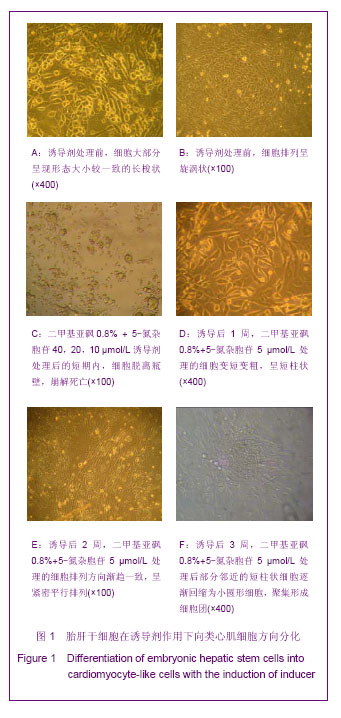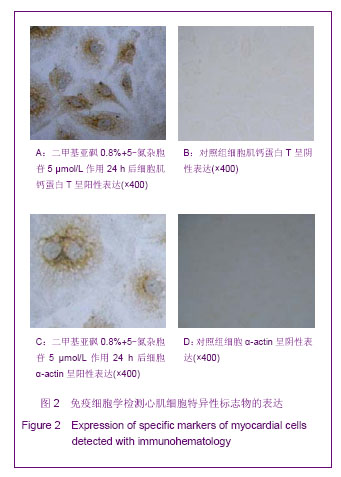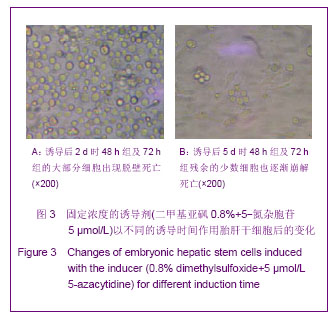| [1] Cho J, Rameshwar P, Sadoshima J. Distinct roles of glycogen synthase kinase (GSK)-3alpha and GSK-3beta in mediating cardiomyocyte differentiation in murine bone marrow-derived mesenchymal stem cells. J Biol Chem. 2009;284(52):36647- 36658.[2] 袁雅红,王泳,丁妍,等.人胎盘源间充质干细胞与人脐血单个核细胞联合移植促进SCID鼠早期造血重建[J].细胞与分子免疫学杂志,2010,26(11): 1097-1100.[3] 张卫泽,樊艳,陈永清,等.血管紧张素Ⅱ对成人脂肪间充质干细胞向心肌细胞分化的影响[J].第四军医大学学报,2008,29(8): 692-695.[4] Koninckx R, Hensen K, Daniëls A,et al. Human bone marrow stem cells co-cultured with neonatal rat cardiomyocytes display limited cardiomyogenic plasticity. Cytotherapy. 2009; 11(6):778-792.[5] Li H, Li X, Lam KS, et al. Adeno-associated virus-mediated pancreatic and duodenal homeobox gene-1 expression enhanced differentiation of hepatic oval stem cells to insulin-producing cells in diabetic rats. J Biomed Sci. 2008; 15(4):487-497.[6] Khurana S, Mukhopadhyay A. Hematopoietic progenitors from early murine fetal liver possess hepatic differentiation potential. Am J Pathol. 2008;173(6):1818-1827.[7] 王先宝,蔡德鸿,张桦,等. 磁标记猪骨髓间充质干细胞肝脏移植示踪研究[J].广东医学,2009,30(3):336-338.[8] Pichard V, Ferry N. Origin of small hepatocyte-like progenitor in retrorsine-treated rats. J Hepatol. 2008;48(2):368-369.[9] Best DH, Coleman WB.Treatment with 2-AAF blocks the small hepatocyte-like progenitor cell response in retrorsine-exposed rats. J Hepatol. 2007;46(6):1055-1063.[10] Yovchev MI, Zhang J, Neufeld DS, et al. Thymus cell antigen-1-expressing cells in the oval cell compartment. Hepatology. 2009;50(2):601-611.[11] 赵文秀,尹震宇,余强峰,等. 小鼠胚胎肝干细胞体外向肝样细胞的诱导分化[J].中国组织工程研究与临床康复, 2009,13(36): 7103-7107.[12] 高植泉,陶开山,李韧,等.体外不同诱导条件下对大鼠胚胎肝干细胞分化影响的实验研究[J].胃肠病学和肝病学杂志, 2010,19(6): 513-516.[13] 宾文婷,孙燕,安威,等.小鼠胚胎与成体肝脏中干细胞变化的探讨[J].肝脏,2006,11(5):330-334.[14] Götherström C, Ringdén O, Tammik C,et al. Immunologic properties of human fetal mesenchymal stem cells. Am J Obstet Gynecol. 2004;190(1):239-245.[15] Dan YY, Yeoh GC. Liver stem cells: a scientific and clinical perspective. J Gastroenterol Hepatol. 2008;23(5):687-698.[16] Weiss TS, Lichtenauer M, Kirchner S,et al. Hepatic progenitor cells from adult human livers for cell transplantation. Gut. 2008; 57(8):1129-1138.[17] Chang J, Cheng JB, Jia FP, et al. Transdifferentiation of Fetal Liver-delivered Mesenchymal Stem Cells into Cardiomyocyte-like Cells. Lingnan Xinxueguanbing Zazhi: Yixueban. 2006;7(2): 78-85.[18] 吴必刚,张晓刚,常静,等.小鼠胎肝干细胞的分离培养与鉴定[J].中国组织工程研究与临床康复,2009,13(10):1877-1880.[19] 史剑慧,胡昕婴,牛玉宏,等.二甲亚砜诱导人骨髓基质干细胞心肌分化中的基因表达[J].复旦学报:医学版,2004,31(5): 454-457.[20] 张荣莉,姜尔烈,王玫,等.骨髓间充质干细胞与心肌细胞共培养诱导分化为心肌样细胞[J].中国实验血液学杂志,2008,16(5):1111- 1115.[21] Pasha Z, Wang Y, Sheikh R, et al. Preconditioning enhances cell survival and differentiation of stem cells during transplantation in infarcted myocardium. Cardiovasc Res. 2008;77(1):134-142. [22] Jiang W, Ma A, Wang T,et al. Intravenous transplantation of mesenchymal stem cells improves cardiac performance after acute myocardial ischemia in female rats.Transpl Int. 2006; 19(7):570-580.[23] 王海萍,张雷,邵素霞,等.二甲基亚砜体外诱导大鼠骨髓间充质干细胞分化为心肌样细胞[J].基础医学与临床,2009,29(9): 938-942.[24] 董松波.5-氮胞苷体外诱导大鼠骨髓间充质干细胞向心肌细胞分化的研究[D].郑州:郑州大学,2011.[25] 王秀力,李春梅,吕茜,等.胰岛素样生长因子1诱导骨髓间充质干细胞分化为心肌样细胞的实验研究[J].中华心血管病杂志,2013, 41(2):150-155.[26] 牛红星,穆军升,张健群,等.骨髓间充质干细胞向心肌分化的实验研究[J].心肺血管病杂志,2013,32(3):357-360.[27] ]高青,季红,胡先同,等.5-氮胞苷联合丹酚酸B促进大鼠骨髓间充质干细胞向心肌样细胞分化[J].天津中医药大学学报,2013, 32(1):24-27.[28] 郭燕,赵凤琴.不同诱导条件下大鼠骨髓间充质干细胞向心肌样细胞分化的比较研究[J].中国医学工程,2012,20(5):74-75,77.[29] 孙庆国,赵文静,王日中,等.体外定向诱导大鼠骨髓间充质干细胞分化为心肌样细胞的实验研究[J].中国实验诊断学,2012,16(12): 2202-2204.[30] 王欢,杨曦,魏琴,等.5-氮胞苷诱导大鼠骨髓间充质干细胞向心肌细胞分化的研究[J].新疆医科大学学报,2012,35(12):1590- 1594.[31] Konieczny SF, Emerson CP Jr. 5-Azacytidine induction of stable mesodermal stem cell lineages from 10T1/2 cells: evidence for regulatory genes controlling determination. Cell. 1984;38(3):791-800.[32] Draper JS, Pigott C, Thomson JA, et al. Surface antigens of human embryonic stem cells: changes upon differentiation in culture.J Anat. 2002;200(Pt 3):249-258. [33] Paquin J, Danalache BA, Jankowski M, et al. Oxytocin induces differentiation of P19 embryonic stem cells to cardiomyocytes. Proc Natl Acad Sci U S A. 2002;99(14): 9550-9555. [34] Makino S, Fukuda K, Miyoshi S, et al. Cardiomyocytes can be generated from marrow stromal cells in vitro. J Clin Invest. 1999;103(5):697-705.[35] Rangappa S, Fen C, Lee EH,et al. Transformation of adult mesenchymal stem cells isolated from the fatty tissue into cardiomyocytes. Ann Thorac Surg. 2003;75(3):775-779. |



.jpg)